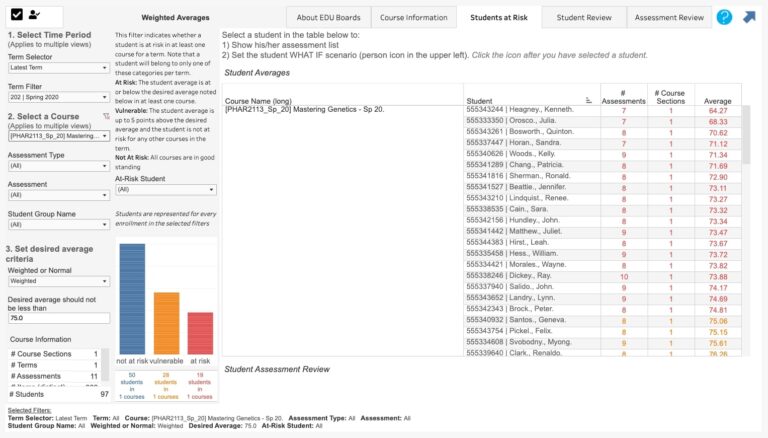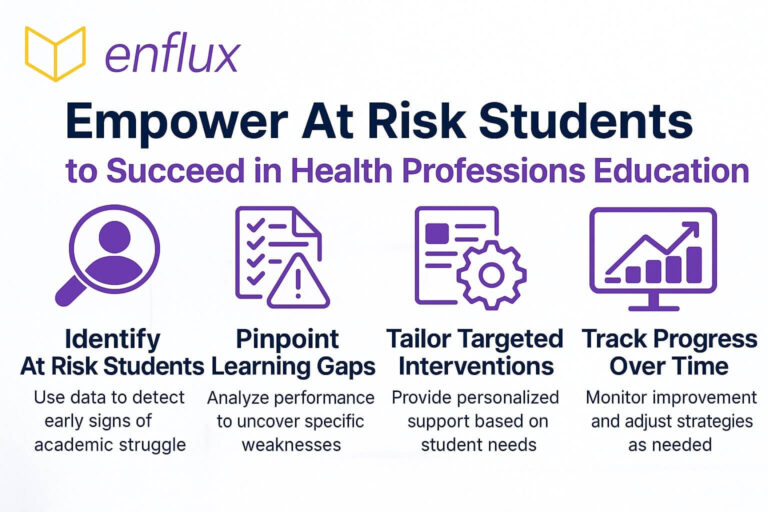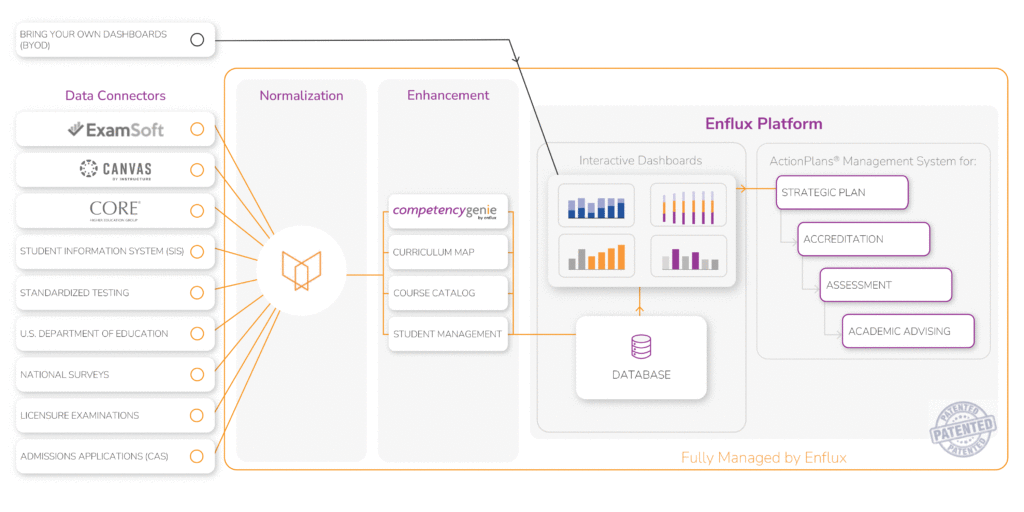
Strengthening Content Retention to Help At Risk Students Succeed in Health Professions Education
Picture this: your students seem to be mastering complex topics, like advanced surgical procedures or intricate pharmacology, until their first high-stakes exam grades reveal that many haven’t actually retained the concepts they appeared to understand. In fast-paced health professions programs, forgetting critical content can have serious repercussions, especially for at risk students. These students at risk of academic failure may fall behind, underperform on high-stakes exams, or even leave the program entirely. The challenge? Catching these signs early and supporting students before they slip through the cracks.
That’s where assessment data comes in. By analyzing exam results and data from tagged exam items—whether they’re for anatomy, pathology, or clinical skills—you can focus on at risk students in education and ensure you are supporting students before they fall through the cracks. The best part? Helping at risk students retain core health professions content sets them up for long-term success and improves overall student retention in your program.
The power of summative assessment data for supporting at-risk students
Summative assessments are often viewed as end-of-semester milestones, but there’s highly valuable information in the data they generate during the semester as well. When you tag your exam questions and use a data analytics solution for academic performance—like Enflux—you get more than basic exam scores; you gain detailed insights into which topics at risk students truly understand and which ones they are not retaining.

Overview of students at risk within student performance and course metrics dashboard by Enflux
In many health professions programs, students move quickly from one complex subject to the next—radiology, pharmacology, surgery, you name it. By regularly analyzing summative assessment data, you can identify exactly where students at risk of dropping out are struggling. For instance, if 40% of the class consistently struggles with understanding pharmacokinetics in clinical scenarios, that’s a clear signal to intervene, most importantly, before those gaps become a barrier in future clinical rotations.
Identifying content areas of difficulty—before it’s too late
We’ve all had that moment when we check exam results and realize the majority of our students missed the same question. It can be even more exasperating when you expected the cohort to excel on that item. Rather than dismissing it as “just one of those tricky” questions, in-depth data from your item tagging can help you see whether the entire class is confusing two similar concepts or truly lacking foundational knowledge. This insight is especially important for academically at-risk students.
Over time, these exam trends can reveal a clear pattern: maybe your students are mixing up core ideas or are struggling to apply certain principles when solving problems. By digging into the data from your exam category tagging in ExamSoft, you’ll know exactly which lessons need reinforcement. This not only provides a roadmap for helping your current cohort succeed but also gives you the opportunity to adjust your teaching before the next iteration of the course, essential for teaching at risk students more effectively.
Spotting high risk students early to protect retention
While overall data tells you which topics need a second look, learning analytics dashboards also have the power to highlight individual high risk students who might be in danger of failing a course. With these dashboards, you can catch the early signs of poor content retention, like persistently low scores on formative assessments or repeated struggles in complex clinical care, and address them now rather than waiting for a midterm failure. While formative assessments are frequently used to check student progress and help advance the learning process, they also provide us with actionable student performance data. The insights provided by these assessments help inform how we should instruct and support students moving forward.
Being proactive and having early-alert programs in place does more than raise exam scores—it improves the overall student experience. When learners know that their success is genuinely cared about and that faculty are committed to helping at risk students, they’re more likely to persevere rather than withdraw.
Creating AI-generated learning materials to reinforce retention
One of the most powerful ways to address these identified content gaps is through AI-driven supplemental materials. Here’s how:
- Pinpoint weak spots. Determine where at risk students are struggling—let’s say it’s in infectious diseases or clinical decision-making.
- Generate targeted resources. Use AI-based tools to create assessments, case scenario simulations, or engaging self-paced modules that directly address these problem areas.
Free Resource: AI Prompts Worksheet for Higher Education Professionals
- Validate and personalize. Have content experts infuse their expertise to ensure the material is accurate and relevant to your program’s goals.
By focusing on exactly what at risk students find challenging, they’re more likely to improve—and, most importantly, retain—the knowledge. This leads to improved performance in your program and greater preparedness for professional licensing exams down the road.
📢 Want to learn more about boosting student performance outcomes with AI?
Register for our webinar: AI in Higher Education: Helping At-Risk Students Succeed in High-Stakes Health Professions Exams.
Register for our webinar: AI in Higher Education: Helping At-Risk Students Succeed in High-Stakes Health Professions Exams.
Building personalized action plans for lasting knowledge
Data isn’t worth much unless you put it into action. After identifying at risk students, here’s how to move forward:
- Identify specific gaps. Provide students with precise feedback (e.g., “You’re strong in musculoskeletal anatomy but need more practice with cardiovascular physiology and clinical reasoning.”).
- Assign key stakeholders. Pair each at risk student with the appropriate faculty member or mentor. Using a transparent feature like Enflux’s ActionPlan® Management System keeps everyone in the loop, eliminating any confusion about follow-up responsibilities.
- Provide targeted materials. Distribute those AI-generated remedial self-paced modules and practice assessments.
- Encourage self-assessment. Instruct students to evaluate their own progress and reflect on which areas need further practice.
- Periodic follow-up. Regularly review your Action Plans, add notes on student progress, continue necessary communication, and assign additional remedial modules as needed.
These individualized plans create effective programs for students at risk and demonstrate that your program is deeply invested in their success.
Real-time intervention vs. reactive measures for at-risk students

We’ve all witnessed the worst-case scenario after final exams—when learners realize too late that they never fully grasped concepts such as advanced surgical procedures or core microbiology fundamentals. By then, remediation feels like a scramble, and the stress can push at risk students closer to leaving the program.
On the flip side, real-time interventions—through frequent data reviews and early student outreach—keep student retention issues small and manageable. When students stay engaged and confident, they remain on track through clinical rotations and ultimately toward graduation.
When at risk students truly retain foundational knowledge, they’re set up for success at every stage of their training—from pre-clinical basics to hands-on clinical practice. This leads to fewer withdrawals, fewer repeats of challenging courses, and a more cohesive, confident cohort entering the healthcare field.
Bringing it together. What is an at risk student?
So, what is an at risk student? It’s someone whose academic trajectory shows warning signs—low assessment scores, disengagement, repeated misunderstandings—indicating that they may fail or drop out without proactive intervention. Whether it’s due to academic, personal, or systemic factors, the goal is always the same: provide support early and often.
By making data your ally and investing in personalized, AI-driven solutions, your institution can deliver high-impact support to at risk students, ensuring stronger content retention, lower attrition, and greater success across your health professions programs.

Dan Thompson, MEd
Assistant Director of Faculty Development and Instructional DesignOklahoma State University College of Veterinary Medicine.

Empower at risk students with data-driven insights
Don’t let knowledge gaps lead to dropouts. Use Enflux to identify, support, and uplift at risk students in your health professions program.


